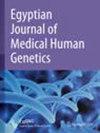初步研究:COVID-19幸存者的营养基因组学分析结果
IF 1.2
Q4 GENETICS & HEREDITY
引用次数: 0
摘要
人们在预防和治疗 COVID-19 方面做了大量尝试。特定的基因型有导致临床症状的风险,这可能是有益的,也可能是有害的。我们对治疗期间使用呼吸机的 COVID-19 幸存者和不需要呼吸机的轻度 COVID-19 幸存者进行了营养基因组学检测,以确定通过营养基因组学检测有关 COVID-19 发病率的基因变异风险。我们从唾液中分离出 DNA,并使用市售的营养基因组学检测方法对遗传标记进行基因分型。我们比较了症状严重者(病例)和症状轻微者(对照组)的基因型频率。测序结果显示,在对照组中,桑基图的分布模式包括一个超风险类别,而在病例组中则没有。病例组中没有一个受试者属于抗逆力超高风险类别。对照组和个案组都观察到了风险等级分布的描述性模式。对照组中有一名受试者属于超风险类别,这表明严重 COVID-19 的风险系数较低。从这项研究中,一个独特之处开始出现,揭示了在对照组的耐力中发现了超类别模式。与被归类为 "典型 "的轻度组相比,重度 COVID-19 组的维生素 E 缺乏风险明显更高。本文章由计算机程序翻译,如有差异,请以英文原文为准。
Preliminary study: nutrigenomics analysis results of COVID-19 survivors
Numerous attempts have been made at both prevention and treatment of COVID-19. Specific genotypes carry a risk of causing clinical symptoms that can be beneficial or detrimental. We performed nutrigenomics testing on COVID-19 survivors who were on ventilators during their treatment and mild COVID-19 survivors who did not require ventilators to determine the risk of genetic variation through nutrigenomic testing regarding COVID-19 incidence. DNA was isolated from saliva and genotyped for genetic markers using a commercially available nutrigenomics test. We compared genotype frequencies between those with severe symptoms (cases) and those with mild symptoms (controls). Sequencing results showed that the distribution from pattern of the Sankey diagram included an ultra risk category in the control group, but not in the case group. None of the subjects in the case group were in the ultra risk category for resilience. A descriptive pattern of risk-level distribution was observed in both the control and case groups. One subject in the ultra risk category was in the control group, indicating a lower risk factor for severe COVID-19. From this study, a uniqueness begins to emerge, revealing the discovery of ultra-category patterns in the endurance of the control group. The vitamin E risk deficiency is significantly higher in the severe COVID-19 group compared to the mild group, categorized as "typical."
求助全文
通过发布文献求助,成功后即可免费获取论文全文。
去求助
来源期刊

Egyptian Journal of Medical Human Genetics
Medicine-Genetics (clinical)
CiteScore
2.20
自引率
7.70%
发文量
150
审稿时长
18 weeks
 求助内容:
求助内容: 应助结果提醒方式:
应助结果提醒方式:


